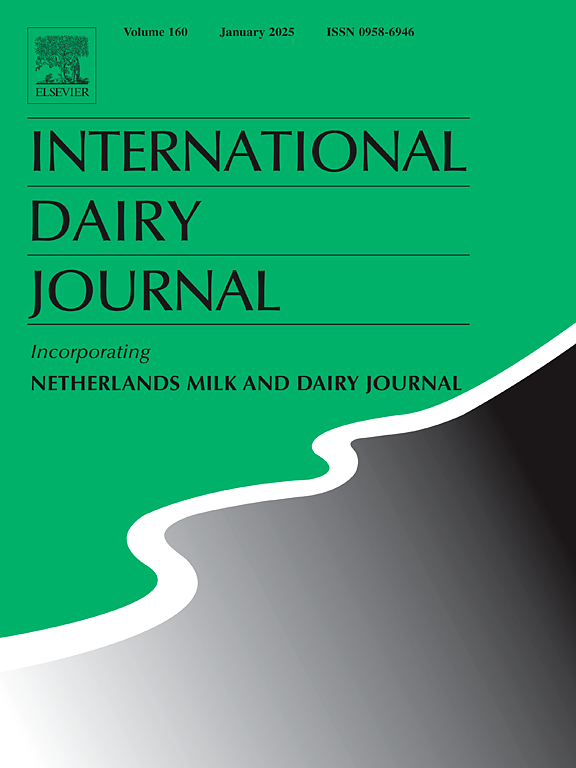IF 3.4
3区 农林科学
Q2 FOOD SCIENCE & TECHNOLOGY
引用次数: 0
摘要
牦牛奶是一种未被充分开发的高海拔乳品资源。本研究系统评估了地理(四川vs.青海;若尔盖vs.宏远)和季节(夏季vs.秋季)在营养和功能方面的差异。结果表明,四川牛奶的脂肪、蛋白质和总固形物含量均高于青海牛奶。若尔盖和宏远奶的共轭亚油酸(CLA)和α-亚麻酸(ALA)含量最高,形成了饱和脂肪酸(SFA)/不饱和脂肪酸(UFA)比例最佳的心脏保护脂肪酸三元组。四川奶的奇链脂肪酸含量高出18 - 31%,脂质抗氧化活性高出23 - 35%。蛋白质分析显示,若尔盖夏季奶酪蛋白、β-CN/α-CN比值、乳铁蛋白和免疫球蛋白含量均升高,表明其具有优越的胶束稳定性和免疫潜力。季节性模式显示,夏季牛奶富含胰岛素样生长因子-1 (IGF-1)、溶菌酶和维生素C,而秋季牛奶含有更高的蛋白质和硒。这些研究结果为确定牦牛乳作为高海拔人群功能性乳源提供了科学依据。本文章由计算机程序翻译,如有差异,请以英文原文为准。
Geographical and seasonal dynamics of nutritional and functional profiles in Maiwa yak milk from the Qinghai-Tibetan Plateau
Yak milk is an underexplored high-altitude dairy resource. This study systematically evaluated geographical (Sichuan vs. Qinghai; Zoige vs. Hongyuan) and seasonal (summer vs. autumn) variations in nutritional and functional profiles. Results showed that Sichuan milk contained higher fat, protein, and total solids than Qinghai. Zoige and Hongyuan milk exhibited highest conjugated linoleic acid (CLA) and α-linolenic acid (ALA), forming cardioprotective fatty acid triad with optimized saturated fatty acid (SFA)/unsaturated fatty acids (UFA) ratios. Sichuan milk also presented 18–31 % more odd-chain fatty acids and 23–35 % greater lipid antioxidant activity. Protein analysis revealed that Zoige summer milk had elevated casein, β-CN/α-CN ratios, lactoferrin, and immunoglobulins, indicating superior micelle stability and immune potential. Seasonal patterns showed summer milk enriched in insulin-like growth factor-1 (IGF-1), lysozyme, and vitamin C, while autumn milk had higher protein and selenium. These findings provide scientific basis for valorizing yak milk as functional dairy source for high-altitude populations.
求助全文
通过发布文献求助,成功后即可免费获取论文全文。
去求助
来源期刊

International Dairy Journal
工程技术-食品科技
CiteScore
6.50
自引率
9.70%
发文量
200
审稿时长
49 days
期刊介绍:
The International Dairy Journal publishes significant advancements in dairy science and technology in the form of research articles and critical reviews that are of relevance to the broader international dairy community. Within this scope, research on the science and technology of milk and dairy products and the nutritional and health aspects of dairy foods are included; the journal pays particular attention to applied research and its interface with the dairy industry.
The journal''s coverage includes the following, where directly applicable to dairy science and technology:
• Chemistry and physico-chemical properties of milk constituents
• Microbiology, food safety, enzymology, biotechnology
• Processing and engineering
• Emulsion science, food structure, and texture
• Raw material quality and effect on relevant products
• Flavour and off-flavour development
• Technological functionality and applications of dairy ingredients
• Sensory and consumer sciences
• Nutrition and substantiation of human health implications of milk components or dairy products
International Dairy Journal does not publish papers related to milk production, animal health and other aspects of on-farm milk production unless there is a clear relationship to dairy technology, human health or final product quality.
 求助内容:
求助内容: 应助结果提醒方式:
应助结果提醒方式:


